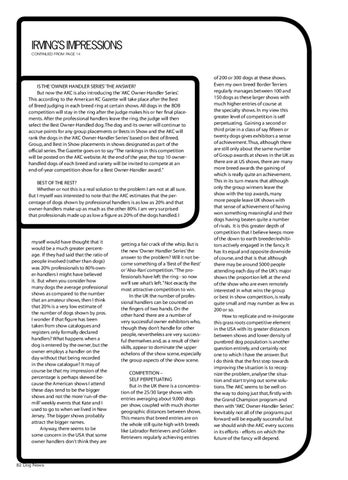IRVING’s ImpREssIONs CoNtiNueD FRoM page 14
IS THE ‘OWNER HANDLER SERIES’ THE ANSWER? But now the AKC is also introducing the ‘AKC Owner-Handler Series’. This according to the American KC Gazette will take place after the Best of Breed judging in each breed ring at certain shows. All dogs in the BOB competition will stay in the ring after the judge makes his or her final placements. After the professional handlers leave the ring, the judge will then select the Best Owner-Handled dog. The dog and its owner will continue to accrue points for any group placements or Bests in Show and the AKC will rank the dogs in the ‘AKC Owner-Handler Series’ based on Best of Breed, Group, and Best in Show placements in shows designated as part of the official series. The Gazette goes on to say “The rankings in this competition will be posted on the AKC website. At the end of the year, the top 10 ownerhandled dogs of each breed and variety will be invited to compete at an end-of-year competition show for a Best Owner-Handler award.” BEST OF THE REST? Whether or not this is a real solution to the problem I am not at all sure. But I myself was interested to note that the AKC estimates that the percentage of dogs shown by professional handlers is as low as 20% and that owner-handlers make up as much as the other 80%. I am very surprised that professionals made up as low a figure as 20% of the dogs handled. I
myself would have thought that it would be a much greater percentage. If they had said that the ratio of people involved (rather than dogs) was 20% professionals to 80% owner-handlers I might have believed it. But when you consider how many dogs the average professional shows as compared to the number that an amateur shows, then I think that 20% is a very low estimate of the number of dogs shown by pros. I wonder if that figure has been taken from show catalogues and registers only formally declared handlers? What happens when a dog is entered by the owner, but the owner employs a handler on the day without that being recorded in the show catalogue? It may of course be that my impression of the percentage is perhaps skewed because the American shows I attend these days tend to be the bigger shows and not the more ‘run-of-themill’ weekly events that Kate and I used to go to when we lived in New Jersey. The bigger shows probably attract the bigger names. Anyway, there seems to be some concern in the USA that some owner handlers don’t think they are
82 Dog News
getting a fair crack of the whip. But is the new ‘Owner Handler Series’ the answer to the problem? Will it not become something of a ‘Best of the Rest’ or ‘Also-Ran’ competition. “The professionals have left the ring - so now we’ll see what’s left.” Not exactly the most attractive competition to win. In the UK the number of professional handlers can be counted on the fingers of two hands. On the other hand there are a number of very successful owner exhibitors who, though they don’t handle for other people, nevertheless are very successful themselves and, as a result of their skills, appear to dominate the upper echelons of the show scene, especially the group aspects of the show scene. COMPETITION – SELF PERPETUATING But in the UK there is a concentration of the 25/30 large shows with entries averaging about 9,000 dogs per show, coupled with much shorter geographic distances between shows. This means that breed entries are on the whole still quite high with breeds like Labrador Retrievers and Golden Retrievers regularly achieving entries
of 200 or 300 dogs at these shows. Even my own breed Border Terriers regularly manages between 100 and 150 dogs as these larger shows with much higher entries of course at the specialty shows. In my view this greater level of competition is self perpetuating. Gaining a second or third prize in a class of say fifteen or twenty dogs gives exhibitors a sense of achievement. Thus, although there are still only about the same number of Group awards at shows in the UK as there are at US shows, there are many more breed awards the gaining of which is really quite an achievement. This in its turn means that although only the group winners leave the show with the top awards, many more people leave UK shows with that sense of achievement of having won something meaningful and their dogs having beaten quite a number of rivals. It is this greater depth of competition that I believe keeps more of the down to earth breeder/exhibitors actively engaged in the fancy. It has its equal and opposite downside of course, and that is that although there may be around 5000 people attending each day of the UK’s major shows the proportion left at the end of the show who are even remotely interested in what wins the group or best in show competition, is really quite small and may number as few as 200 or so. How to replicate and re-invigorate this grass roots competitive element in the USA with its greater distances between shows and lower density of purebred dog population is another question entirely, and certainly not one to which I have the answer. But I do think that the first step towards improving the situation is to recognize the problem, analyse the situation and start trying out some solutions. The AKC seems to be well on the way to doing just that, firstly with the Grand Champion program and then with “AKC Owner-Handler Series”. Inevitably not all of the programs put forward will be equally successful but we should wish the AKC every success in its efforts - efforts on which the future of the fancy will depend.
